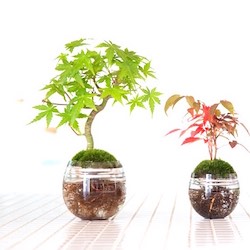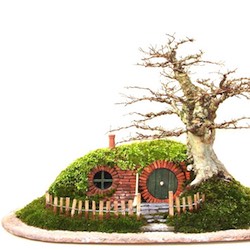Lingnan Penjing artists prune trees with the “Clip and Grow” method. By using this pruning method, Penjing artists do not use much, if any, of the wiring technique when training and styling their trees, but simply keep clipping the branches as they grow.
The advantage of the “Grow and Clip” method is that the tree will establish a very natural look. As the tree keeps growing and being pruned, the branches will develop many fine turns and twists that are naturally proportional. That’s why we find that Bonsai trees of Lingnan Penjing style are often defoliated when shown in Bonsai exhibitions. We should show off all these beautiful branches, shouldn’t we? It would be such a waste to hide them under the foliage.
But like everything else in the world, when there is a good side, there also must be a bad side. I bet all of us agree that patience is vital in the art of Bonsai. It takes years if not decades to train and develop a tree that is presentable. And when one uses only the “Grow and Clip” method, the time it takes will even be tremendously longer than those who train and develop their trees with the wiring techniques.
To cut the awful waiting time shorter, there are two approaches everyone in the Institute of Lingnan Penjing, Hong Kong uses. First, we use wires. Of course, we develop our trees mainly by “Grow and Clip”, but we often use guy wire to hold a bended branch into position. Once the position of the branch is set, we will unwire the branch immediately. Then, clip the branch, and anticipate the growth of new buds on the branch. Even with such limited use of wiring, the time of developing a branch can be cut much shorter than those using only the “Grow and Clip” method.
Secondly, if the tree is in its early stage of development, we can plant the tree on the ground instead of in a pot. If the tree is growing in a pot, we can put the tree together with its pot on top of a bigger pot that is filled with sand or soil. More growing media means more nutrients and moisture sit available for the tree, which then means faster growth of the tree.
While Penjing schools will continue to keep their distinctive Bonsai techniques and styles, they will also adopt techniques of others when see suitable. While the difference between different Bonsai schools may become less distinctive, more ideas will be exchanged and new Bonsai techniques will got developed as the art of Penjing / Bonsai is getting more and more popular around the world. Read more about the History of Bonsai. and the meaning and definition of Bonsai.
Written by: Sandy Wong, Happy bonsai. "Sandy has a keen interest in the art of Bonsai and urban gardening. She is an author of Happy Bonsai. where she shares all the interesting things, new techniques and knowledge about Bonsai and gardening that she has learned during the day."






